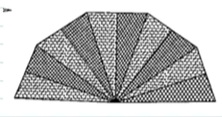A parallelogram and a square have the same area. If the sides of the square measure 40 m and corresponding base of the parallelogram.
44 m
54 m
64 m
74 m
The correct Answer is:C
To solve the problem, we need to find the base of the parallelogram given that it has the same area as a square with a side length of 40 m.
1. Calculate the Area of the Square:
The area A of a square is given by the formula:
A=side2
Given the side of the square is 40 m:
A=40×40=1600m2
2. Set the Area of the Parallelogram Equal to the Area of the Square:
The area of a parallelogram is given by the formula:
Area=base×height
Since the area of the parallelogram is equal to the area of the square, we have:
base×height=1600m2
3. Identify the Height of the Parallelogram:
The problem states that the height of the parallelogram is 25 m (assuming the height is given in meters, as the question does not specify units for the height).
4. Substitute the Height into the Area Equation:
Now we can substitute the height into the area equation:
base×25=1600
5. Solve for the Base:
To find the base, we rearrange the equation:
base=160025
Now, calculate the base:
base=64m
Final Answer:
The corresponding base of the parallelogram is 64 m.
The area A of a square is given by the formula:
A=side2
Given the side of the square is 40 m:
A=40×40=1600m2
The area of a parallelogram is given by the formula:
Area=base×height
Since the area of the parallelogram is equal to the area of the square, we have:
base×height=1600m2
The problem states that the height of the parallelogram is 25 m (assuming the height is given in meters, as the question does not specify units for the height).
Now we can substitute the height into the area equation:
base×25=1600
To find the base, we rearrange the equation:
base=160025
Now, calculate the base:
base=64m
The corresponding base of the parallelogram is 64 m.
Topper's Solved these Questions
- AREAS OF TRIANGLES AND QUADRILATERALSBOOK - RS AGGARWALCHAPTER - AREAS OF TRIANGLES AND QUADRILATERALSEXERCISE - EXERCISE
12 Videos
- AREAS OF TRIANGLES AND QUADRILATERALSBOOK - RS AGGARWALCHAPTER - AREAS OF TRIANGLES AND QUADRILATERALSEXERCISE - Multiple Choice Questions (Mcq)
16 Videos
- AREAS OF TRIANGLES AND QUADRILATERALSBOOK - RS AGGARWALCHAPTER - AREAS OF TRIANGLES AND QUADRILATERALSEXERCISE - EXAMPLE
6 Videos
- AREAS OF PARALLELOGRAMS AND TRIANGLES BOOK - RS AGGARWALCHAPTER - AREAS OF PARALLELOGRAMS AND TRIANGLES EXERCISE - ASSERTION & REASON TYPE
5 Videos
- BAR GRAPH, HISTOGRAM AND FREQUENCY POLYGONBOOK - RS AGGARWALCHAPTER - BAR GRAPH, HISTOGRAM AND FREQUENCY POLYGONEXERCISE - EXERCISE 17B
16 Videos
Similar Questions
The area of a parallelogram and a square are the same.If the perimeter of the square is 160 m and the height of the parallelogram is 20 m ,find the length of the corresponding base of the parallelogram.
View SolutionA triangle and a parallelogram have the same base and the same area. If the sides of the triangle are 26cm,28cm and 30cm, and the parallelogram stands on the base 28cm, find the height of the parallelogram.
View Solution
Knowledge Check
A rectangle and a parallelogram have equal areas. If the sides of a rectangle are 10 m and 12 m and the base of the parallelogram is 20 m, then the altitude of the parallelogram is
A7 mB6 mC5 mD3 mA rhombus and a square have the same base. If the diagonals of the rhombus measure 30 cm and 16 cm respectively, find the area of the square.
A225 cm2B200 cm2C240 cm2D289 cm2A circle and a square have same area. The ratio of the side of the square to the radius of the circle will be :
A√π:1B1:√πC1:πDπ:1
A hand fan is made by stitching 10 equal size triangular strips of two different types of paper as shown in figure. The dimensions of equal strips are 25 cm, 25 cm and 14 cm. Find the area of each type of paper needed to make the fan

View SolutionA rectangle and a parallelogram have equal areas. If the sides of the rectangle are 10 m and 12 m and the base of the parallelogram is 20 m, then the altitude of the parallelogram is (a) 3 m (b) 5 m (c) 6 m (d) 7 m
View SolutionA triangle and a parallelogram have the same base and the same area. If the sides of the triangle are 26 cm, 28 cm and 30 cm, and the parallelogram stands on the base 28 cm, find the height of the parallelogram.
View SolutionA triangle and a parallelogram have the same base and the same area. If the sides of the triangle are 26cm, 28cm and 30cm, and the parallelogram stands on the base 28cm, find the height of the parallelogram.
View SolutionA triangle and a parallelogram have the same base and same area. If the sides of the triangle are 9cm, 12cm, 15cm and the parallelogram stands on the base 9cm, find the height of the parallelogram.
View Solution
